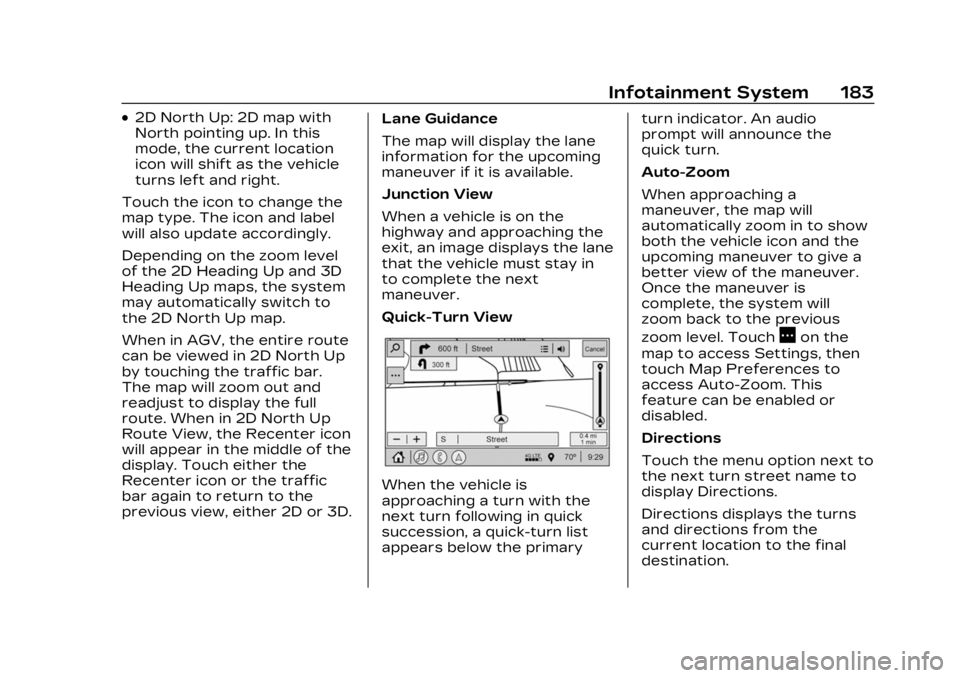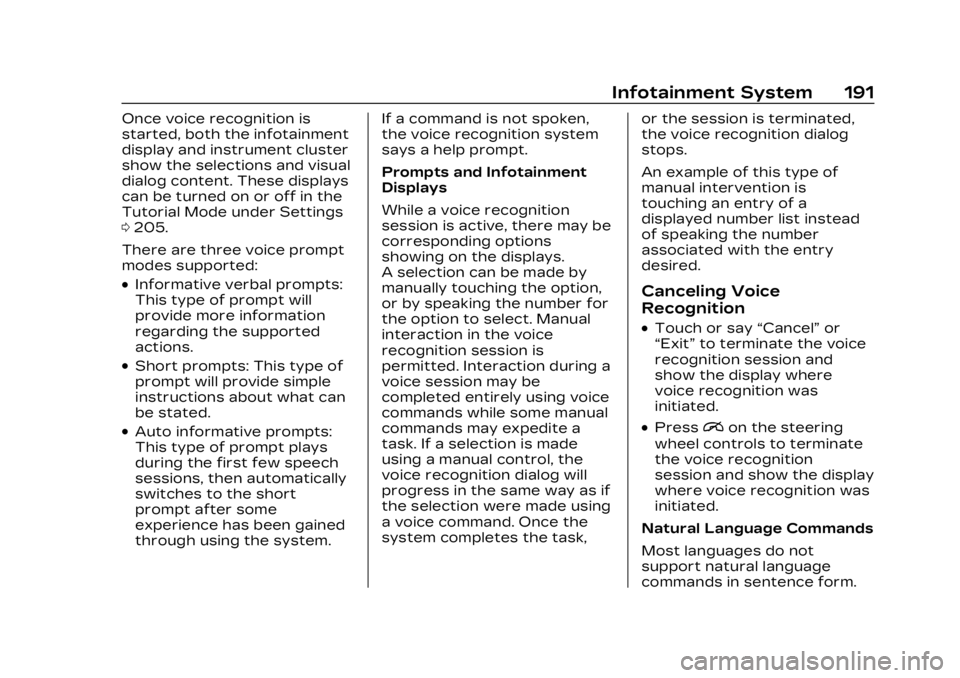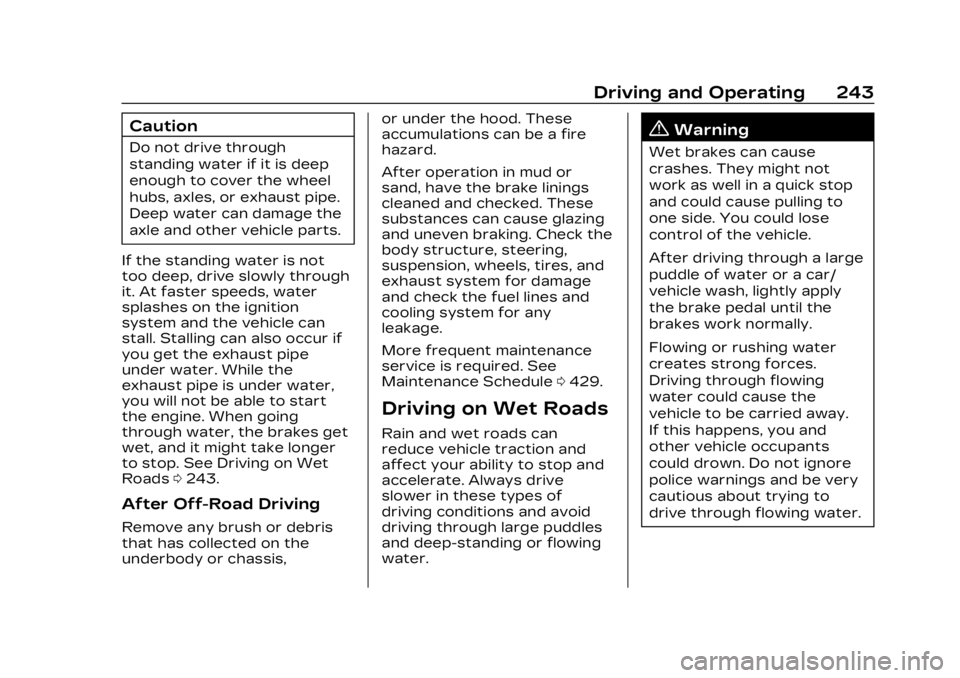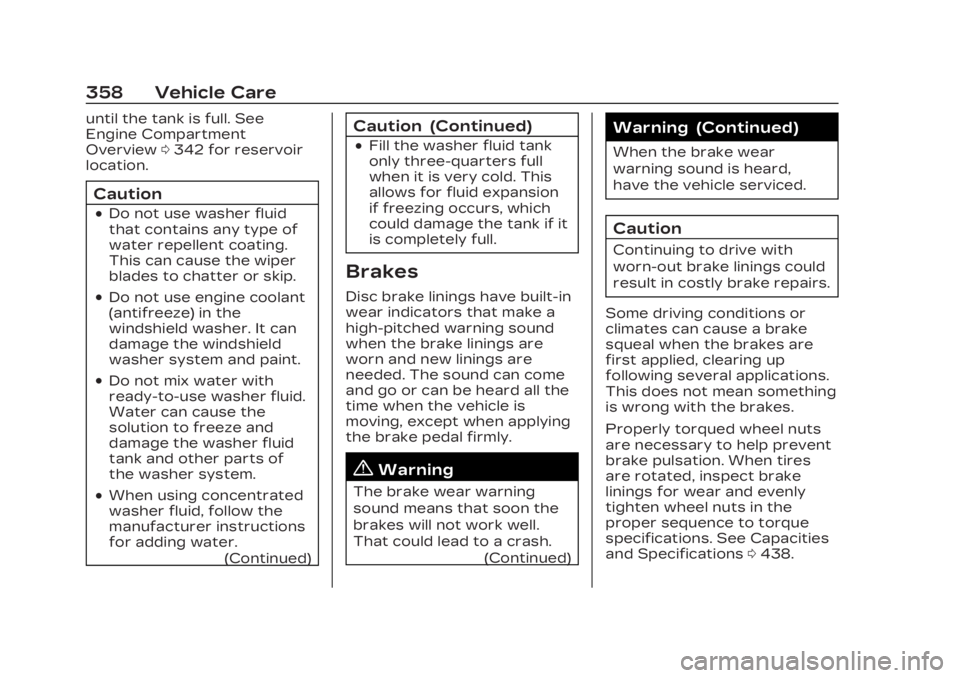tire type CADILLAC XT5 2023 Owners Manual
[x] Cancel search | Manufacturer: CADILLAC, Model Year: 2023, Model line: XT5, Model: CADILLAC XT5 2023Pages: 482, PDF Size: 7.1 MB
Page 184 of 482

Cadillac XT5 Owner Manual (GMNA-Localizing-U.S./Canada/Mexico-
16406251) - 2023 - CRC - 3/25/22
Infotainment System 183
.2D North Up: 2D map with
North pointing up. In this
mode, the current location
icon will shift as the vehicle
turns left and right.
Touch the icon to change the
map type. The icon and label
will also update accordingly.
Depending on the zoom level
of the 2D Heading Up and 3D
Heading Up maps, the system
may automatically switch to
the 2D North Up map.
When in AGV, the entire route
can be viewed in 2D North Up
by touching the traffic bar.
The map will zoom out and
readjust to display the full
route. When in 2D North Up
Route View, the Recenter icon
will appear in the middle of the
display. Touch either the
Recenter icon or the traffic
bar again to return to the
previous view, either 2D or 3D. Lane Guidance
The map will display the lane
information for the upcoming
maneuver if it is available.
Junction View
When a vehicle is on the
highway and approaching the
exit, an image displays the lane
that the vehicle must stay in
to complete the next
maneuver.
Quick-Turn View
When the vehicle is
approaching a turn with the
next turn following in quick
succession, a quick-turn list
appears below the primaryturn indicator. An audio
prompt will announce the
quick turn.
Auto-Zoom
When approaching a
maneuver, the map will
automatically zoom in to show
both the vehicle icon and the
upcoming maneuver to give a
better view of the maneuver.
Once the maneuver is
complete, the system will
zoom back to the previous
zoom level. Touch
Aon the
map to access Settings, then
touch Map Preferences to
access Auto-Zoom. This
feature can be enabled or
disabled.
Directions
Touch the menu option next to
the next turn street name to
display Directions.
Directions displays the turns
and directions from the
current location to the final
destination.
Page 192 of 482

Cadillac XT5 Owner Manual (GMNA-Localizing-U.S./Canada/Mexico-
16406251) - 2023 - CRC - 3/25/22
Infotainment System 191
Once voice recognition is
started, both the infotainment
display and instrument cluster
show the selections and visual
dialog content. These displays
can be turned on or off in the
Tutorial Mode under Settings
0205.
There are three voice prompt
modes supported:
.Informative verbal prompts:
This type of prompt will
provide more information
regarding the supported
actions.
.Short prompts: This type of
prompt will provide simple
instructions about what can
be stated.
.Auto informative prompts:
This type of prompt plays
during the first few speech
sessions, then automatically
switches to the short
prompt after some
experience has been gained
through using the system. If a command is not spoken,
the voice recognition system
says a help prompt.
Prompts and Infotainment
Displays
While a voice recognition
session is active, there may be
corresponding options
showing on the displays.
A selection can be made by
manually touching the option,
or by speaking the number for
the option to select. Manual
interaction in the voice
recognition session is
permitted. Interaction during a
voice session may be
completed entirely using voice
commands while some manual
commands may expedite a
task. If a selection is made
using a manual control, the
voice recognition dialog will
progress in the same way as if
the selection were made using
a voice command. Once the
system completes the task,
or the session is terminated,
the voice recognition dialog
stops.
An example of this type of
manual intervention is
touching an entry of a
displayed number list instead
of speaking the number
associated with the entry
desired.
Canceling Voice
Recognition
.Touch or say
“Cancel”or
“Exit” to terminate the voice
recognition session and
show the display where
voice recognition was
initiated.
.Pression the steering
wheel controls to terminate
the voice recognition
session and show the display
where voice recognition was
initiated.
Natural Language Commands
Most languages do not
support natural language
commands in sentence form.
Page 239 of 482

Cadillac XT5 Owner Manual (GMNA-Localizing-U.S./Canada/Mexico-
16406251) - 2023 - CRC - 3/25/22
238 Driving and Operating
.The Antilock Brake System
(ABS) allows steering while
braking.
Off-Road Recovery
The vehicle's right wheels can
drop off the edge of a road
onto the shoulder while
driving. Follow these tips:1. Ease off the accelerator and then, if there is
nothing in the way, steer
the vehicle so that it
straddles the edge of the
pavement. 2. Turn the steering wheel
about one-eighth of a turn,
until the right front tire
contacts the
pavement edge.
3. Turn the steering wheel to go straight down the
roadway.
Loss of Control
Skidding
There are three types of skids
that correspond to the
vehicle's three control
systems:
.Braking Skid —wheels are
not rolling.
.Steering or Cornering Skid —
too much speed or steering
in a curve causes tires to slip
and lose cornering force.
.Acceleration Skid —too
much throttle causes the
driving wheels to spin.
Defensive drivers avoid most
skids by taking reasonable
care suited to existing conditions, and by not
overdriving those conditions.
But skids are always possible.
If the vehicle starts to slide,
follow these suggestions:
.Ease your foot off the
accelerator pedal and steer
the way you want the vehicle
to go. The vehicle may
straighten out. Be ready for
a second skid if it occurs.
.Slow down and adjust your
driving according to weather
conditions. Stopping
distance can be longer and
vehicle control can be
affected when traction is
reduced by water, snow, ice,
gravel, or other material on
the road. Learn to recognize
warning clues
—such as
enough water, ice, or packed
snow on the road to make a
mirrored surface —and slow
down when you have any
doubt.
.Try to avoid sudden
steering, acceleration,
or braking, including
Page 244 of 482

Cadillac XT5 Owner Manual (GMNA-Localizing-U.S./Canada/Mexico-
16406251) - 2023 - CRC - 3/25/22
Driving and Operating 243
Caution
Do not drive through
standing water if it is deep
enough to cover the wheel
hubs, axles, or exhaust pipe.
Deep water can damage the
axle and other vehicle parts.
If the standing water is not
too deep, drive slowly through
it. At faster speeds, water
splashes on the ignition
system and the vehicle can
stall. Stalling can also occur if
you get the exhaust pipe
under water. While the
exhaust pipe is under water,
you will not be able to start
the engine. When going
through water, the brakes get
wet, and it might take longer
to stop. See Driving on Wet
Roads 0243.
After Off-Road Driving
Remove any brush or debris
that has collected on the
underbody or chassis, or under the hood. These
accumulations can be a fire
hazard.
After operation in mud or
sand, have the brake linings
cleaned and checked. These
substances can cause glazing
and uneven braking. Check the
body structure, steering,
suspension, wheels, tires, and
exhaust system for damage
and check the fuel lines and
cooling system for any
leakage.
More frequent maintenance
service is required. See
Maintenance Schedule
0429.
Driving on Wet Roads
Rain and wet roads can
reduce vehicle traction and
affect your ability to stop and
accelerate. Always drive
slower in these types of
driving conditions and avoid
driving through large puddles
and deep-standing or flowing
water.
{Warning
Wet brakes can cause
crashes. They might not
work as well in a quick stop
and could cause pulling to
one side. You could lose
control of the vehicle.
After driving through a large
puddle of water or a car/
vehicle wash, lightly apply
the brake pedal until the
brakes work normally.
Flowing or rushing water
creates strong forces.
Driving through flowing
water could cause the
vehicle to be carried away.
If this happens, you and
other vehicle occupants
could drown. Do not ignore
police warnings and be very
cautious about trying to
drive through flowing water.
Page 313 of 482

Cadillac XT5 Owner Manual (GMNA-Localizing-U.S./Canada/Mexico-
16406251) - 2023 - CRC - 3/25/22
312 Driving and Operating
Warning (Continued)
.If the person or animal is
moving too quickly
through the field of view,
such as a bicyclist.
.If the pedestrian is
wearing certain types of
clothing.
.If headlamps are off,
except when parked.
.If the outside temperature
is higher than 30 °C
(86 °F).
.Due to poor visibility,
including in heavy fog, rain,
or snow.
.If the sensor is blocked by
dirt, snow, rain, or ice.
Be ready to take action and
apply the brakes. For more
information, see Defensive
Driving 0235. Keep the
Night Vision sensor clean
and in good repair. Pedestrian detection may not
be available in high outside
temperatures. An amber icon,
*, displays. The system does
not need service.
In rain, snow, or fog the image
may not be clear and the
direction of the road ahead
may not be seen. In more
severe weather conditions,
the image may be unclear and
unusable. The system does
not need service.
Keep the system sensor clean
by activating the rear window
washer when it is dark enough
for the system to operate.
If the Night Vision image still
looks blurry, use a soft wet
cloth to gently clean the
sensor camera lens and dry
thoroughly. The sensor is
behind the lower front grille
below the driver side
headlamp.
The camera must also be
aligned to work correctly.
If the camera needs adjustment, see your dealer.
Do not attempt to adjust the
camera yourself.Side Blind Zone
Alert (SBZA)
If equipped, the SBZA system
is a lane-changing aid that
assists drivers with avoiding
crashes that occur with
moving vehicles in the side
blind zone, or blind spot areas.
When the vehicle is in a
forward gear, the left or right
side mirror display will light up
if a moving vehicle is detected
in that blind zone. If the turn
signal is activated and a
vehicle is also detected on the
same side, the display will flash
as an extra warning not to
change lanes. Since this
system is part of the Lane
Change Alert (LCA) system,
read the entire LCA section
before using this feature.
Page 339 of 482

Cadillac XT5 Owner Manual (GMNA-Localizing-U.S./Canada/Mexico-
16406251) - 2023 - CRC - 3/28/22
338 Vehicle Care
If a Tire Goes Flat . . . . . . . . . . 401
Tire Changing . . . . . . . . . . . . . . 402
Compact Spare Tire . . . . . . 408
Jump Starting
Jump Starting - NorthAmerica . . . . . . . . . . . . . . . . . . . . . 409
Towing the Vehicle
Transporting a DisabledVehicle . . . . . . . . . . . . . . . . . . . . . . . 412
Recreational Vehicle Towing . . . . . . . . . . . . . . . . . . . . . . . 414
Appearance Care
Exterior Care . . . . . . . . . . . . . . . . 416
Interior Care . . . . . . . . . . . . . . . . . 421
Floor Mats . . . . . . . . . . . . . . . . . . . 425
General
Information
For service and parts needs,
visit your dealer. You will
receive genuine GM parts and
GM-trained and supported
service people.
Genuine GM parts have one of
these marks:
California Perchlorate
Materials
Requirements
Certain types of automotive
applications, such as airbag
initiators, seat belt
pretensioners, and lithium
batteries contained in
electronic keys, may contain
perchlorate materials.
Perchlorate Material –special
handling may apply. See
www.dtsc.ca.gov/
hazardouswaste/perchlorate.
Accessories and
Modifications
Adding non-dealer accessories
or making modifications to the
vehicle can affect vehicle
performance and safety,
including such things as
airbags, braking, stability, ride
and handling, emissions
systems, aerodynamics,
durability, Driver Assistance
Systems, and electronic
systems like antilock brakes,
Page 359 of 482

Cadillac XT5 Owner Manual (GMNA-Localizing-U.S./Canada/Mexico-
16406251) - 2023 - CRC - 3/28/22
358 Vehicle Care
until the tank is full. See
Engine Compartment
Overview0342 for reservoir
location.
Caution
.Do not use washer fluid
that contains any type of
water repellent coating.
This can cause the wiper
blades to chatter or skip.
.Do not use engine coolant
(antifreeze) in the
windshield washer. It can
damage the windshield
washer system and paint.
.Do not mix water with
ready-to-use washer fluid.
Water can cause the
solution to freeze and
damage the washer fluid
tank and other parts of
the washer system.
.When using concentrated
washer fluid, follow the
manufacturer instructions
for adding water.
(Continued)
Caution (Continued)
.Fill the washer fluid tank
only three-quarters full
when it is very cold. This
allows for fluid expansion
if freezing occurs, which
could damage the tank if it
is completely full.
Brakes
Disc brake linings have built-in
wear indicators that make a
high-pitched warning sound
when the brake linings are
worn and new linings are
needed. The sound can come
and go or can be heard all the
time when the vehicle is
moving, except when applying
the brake pedal firmly.
{Warning
The brake wear warning
sound means that soon the
brakes will not work well.
That could lead to a crash.
(Continued)
Warning (Continued)
When the brake wear
warning sound is heard,
have the vehicle serviced.
Caution
Continuing to drive with
worn-out brake linings could
result in costly brake repairs.
Some driving conditions or
climates can cause a brake
squeal when the brakes are
first applied, clearing up
following several applications.
This does not mean something
is wrong with the brakes.
Properly torqued wheel nuts
are necessary to help prevent
brake pulsation. When tires
are rotated, inspect brake
linings for wear and evenly
tighten wheel nuts in the
proper sequence to torque
specifications. See Capacities
and Specifications 0438.
Page 379 of 482

Cadillac XT5 Owner Manual (GMNA-Localizing-U.S./Canada/Mexico-
16406251) - 2023 - CRC - 3/28/22
378 Vehicle Care
winter tire availability and
proper tire selection. Also, see
Buying New Tires0395.
With winter tires, there may
be decreased dry road
traction, increased road noise,
and shorter tread life. After
changing to winter tires, be
alert for changes in vehicle
handling and braking.
If using winter tires:
.Use tires of the same brand
and tread type on all four
wheel positions.
.Use only radial ply tires of
the same size, load range,
and speed rating as the
original equipment tires.
Winter tires with the same
speed rating as the original
equipment tires may not be
available for H, V, W, Y, and ZR
speed rated tires. If winter
tires with a lower speed rating
are chosen, never exceed the
tire's maximum speed
capability.
Summer Tires
This vehicle may come with
235/55R20 high performance
summer tires. These tires have
a special tread and compound
that are optimized for
maximum dry and wet road
performance. This special
tread and compound will have
decreased performance in
cold climates, and on ice and
snow. It is recommended that
winter tires be installed on the
vehicle if frequent driving at
temperatures below
approximately 5 °C (40 °F) or
on ice or snow covered roads
is expected. See Winter Tires
0 377.
Caution
High performance summer
tires have rubber
compounds that lose
flexibility and may develop
surface cracks in the tread
area at temperatures below
−7 °C (20 °F). Always store
(Continued)
Caution (Continued)
high performance summer
tires indoors and at
temperatures above −7 °C
(20 °F) when not in use. If the
tires have been subjected to
−7 °C (20 °F) or less, let them
warm up in a heated space
to at least 5 °C (40 °F) for
24 hours or more before
being installed or driving a
vehicle on which they are
installed. Do not apply heat
or blow heated air directly
on the tires. Always inspect
tires before use. See Tire
Inspection 0392.
Tire Sidewall Labeling
Useful information about a
tire is molded into its
sidewall. The examples
show a typical passenger
vehicle tire and a compact
spare tire sidewall.
Page 380 of 482

Cadillac XT5 Owner Manual (GMNA-Localizing-U.S./Canada/Mexico-
16406251) - 2023 - CRC - 3/28/22
Vehicle Care 379
Passenger Tire Example
(1) Tire Size:The tire size
is a combination of letters
and numbers used to
define a particular tire's
width, height, aspect ratio,
construction type, and
service description. See the
“Tire Size” illustration in
this section.
(2) TPC Spec (Tire
Performance Criteria
Specification)
:Original
equipment tires designed
to GM's specific tire performance criteria have a
TPC specification code
molded onto the sidewall.
GM's TPC specifications
meet or exceed all federal
safety guidelines.
(3) DOT (Department of
Transportation)
:The
Department of
Transportation (DOT) code
indicates that the tire is in
compliance with the U.S.
Department of
Transportation Motor
Vehicle Safety Standards.
DOT Tire Date of
Manufacture
:The last
four digits of the TIN
indicate the tire
manufactured date. The
first two digits represent
the week and the last two
digits, the year. For
example, the third week of
the year 2020 would have
a 4-digit DOT date of 0320. Week 01 is the first full
week (Sunday through
Saturday) of each year.
(4) Tire Identification
Number (TIN)
:The letters
and numbers following the
DOT (Department of
Transportation) code are
the Tire Identification
Number (TIN). The TIN
shows the manufacturer
and plant code, tire size,
and date the tire was
manufactured. The TIN is
molded onto both sides of
the tire, although only one
side may have the date of
manufacture.
(5) Tire Ply Material
:The
type of cord and number of
plies in the sidewall and
under the tread.
(6) Uniform Tire Quality
Grading (UTQG)
:Tire
manufacturers are required
to grade tires based on
Page 381 of 482

Cadillac XT5 Owner Manual (GMNA-Localizing-U.S./Canada/Mexico-
16406251) - 2023 - CRC - 3/28/22
380 Vehicle Care
three performance factors:
tread wear, traction, and
temperature resistance.
For more information see
Uniform Tire Quality
Grading0397.
(7) Maximum Cold
Inflation Load Limit
:
Maximum load that can be
carried and the maximum
pressure needed to
support that load.
Compact Spare Tire Example
(1) Tire Ply Material:The
type of cord and number of
plies in the sidewall and
under the tread.
(2) Temporary Use Only
:
The compact spare tire or
temporary use tire should
not be driven at speeds
over 80 km/h (50 mph). The
compact spare tire is for
emergency use when a
regular road tire has lost
air and gone flat. If the
vehicle has a compact
spare tire, see Compact
Spare Tire 0408 and
If a Tire Goes Flat 0401.
(3) Tire Identification
Number (TIN)
:The letters
and numbers following the
DOT (Department of
Transportation) code are
the Tire Identification
Number (TIN). The TIN
shows the manufacturer
and plant code, tire size, and date the tire was
manufactured. The TIN is
molded onto both sides of
the tire, although only one
side may have the date of
manufacture.
(4) Maximum Cold
Inflation Load Limit
:
Maximum load that can be
carried and the maximum
pressure needed to
support that load.
(5) Tire Inflation
:The
temporary use tire or
compact spare tire should
be inflated to 420 kPa
(60 psi). For more
information on tire
pressure and inflation see
Tire Pressure 0384.
(6) Tire Size
:A
combination of letters and
numbers define a tire's
width, height, aspect ratio,
construction type, and
service description. The